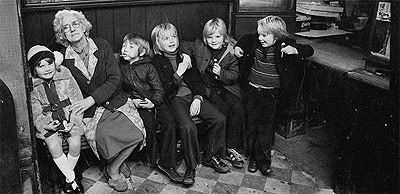
| HOME |
| NERVE |
| REVIEWS |
| ARCHIVE |
| EVENTS |
| LINKS |
| ABOUT US |
| CONTRIBUTORS |
| BACK ISSUES |
| CONTACT US |
 Liverpool
People
Liverpool
People
Stephen Shakeshaft
National Conservation
Centre, Whitechapel
18th September 2009 - 24th January 2010
Reviewed by Adam Ford
"We call them photographs but they are also history; telling of men, women and children and their place in passing events. Once the button on the camera has been pushed these people are given a kind of immortality, for the camera is a third eye, adding permanence to the sight it sees."
This exhibition of more than Liverpool photographs by retired Liverpool Echo and Daily Post picture editor Stephen Shakeshaft showcases his skilled and sensitive - if somewhat uncritical - approach to his craft. But more than this, it provides a pictorial glimpse into the city's past, a 'foreign country' dominated by heavy industry along the docks and strong working class community spirit everywhere else. By showing us what once was, it necessarily points out what is no longer.
The Echo took Shakeshaft on at the tender age of sixteen, in 1962. The Beatles were just beginning their assault on the charts, having built a solid local following from their gigs at the Cavern and elsewhere. From this time, with its Scottie Road doorstep scrubbers and the nearby Limekiln Lane wash house, we see history progress for better and worse, through to the Toxteth uprising and its aftermath. Liverpool fans hang their heads in anguish at the 1977 European Cup final defeat, and supporters of all teams and none gather at Anfield to commiserate over a true disaster - which took place at the Hillsborough Stadium in 1989.
In short, almost all Liverpool life is here, and the overall effect is a nostalgic glow from what Shakeshaft calls the 'magic' of the place, which ultimately boils down to the dogged determination and group solidarity of working class people. Of course, these factors are not only to be found in this one city by any stretch of the imagination. However, the history of especially high unemployment levels and the particular mixture of ethnicities gives the 'magic' a certain flavour.
Shakeshaft demonstrates great empathy with his subjects, which is vital for any serious artist. Using this, he developed a knack of knowing when the chance of an evocative photo would present itself. Nowhere is this more evident than in his portrait of an elderly Edge Hill woman, who with no electricity available keeps a candlelit vigil over her cloth-covered kitchen table. The same applies to the very different image of a young boy playing amongst high tide waves on New Brighton promenade.
Though the region has changed dramatically, Shakeshaft's video commentary gives no great insight into his perspective on these changes. Certainly, working for a major advertising-dependent newspaper for so long, it would have been very difficult to be particularly critical and remain in his relatively comfortable job. For Shakeshaft, a fine photo would seem to be one that gently surprises with a quirkily unusual scene, or a marked contrast of any kind. Still, that's not a bad starting point, and any aspiring photographers in this digital age of ever more extreme contrasts would do well to pay this exhibition a visit.